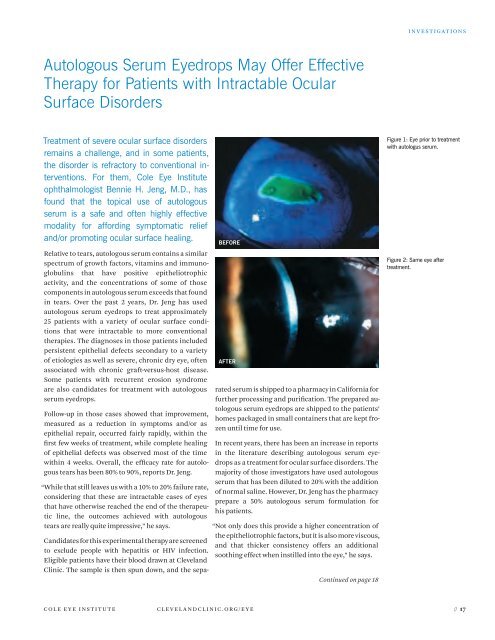Ophthalmology Update - Cleveland Clinic
Ophthalmology Update - Cleveland Clinic
Ophthalmology Update - Cleveland Clinic
Create successful ePaper yourself
Turn your PDF publications into a flip-book with our unique Google optimized e-Paper software.
Autologous Serum Eyedrops May Offer Effective<br />
Therapy for Patients with Intractable Ocular<br />
Surface Disorders<br />
Treatment of severe ocular surface disorders<br />
remains a challenge, and in some patients,<br />
the disorder is refractory to conventional interventions.<br />
For them, Cole Eye Institute<br />
ophthalmologist Bennie H. Jeng, M.D., has<br />
found that the topical use of autologous<br />
serum is a safe and often highly effective<br />
modality for affording symptomatic relief<br />
and/or promoting ocular surface healing.<br />
relative to tears, autologous serum contains a similar<br />
spectrum of growth factors, vitamins and immunoglobulins<br />
that have positive epitheliotrophic<br />
activity, and the concentrations of some of those<br />
components in autologous serum exceeds that found<br />
in tears. Over the past 2 years, dr. Jeng has used<br />
autologous serum eyedrops to treat approximately<br />
25 patients with a variety of ocular surface conditions<br />
that were intractable to more conventional<br />
therapies. the diagnoses in those patients included<br />
persistent epithelial defects secondary to a variety<br />
of etiologies as well as severe, chronic dry eye, often<br />
associated with chronic graft-versus-host disease.<br />
some patients with recurrent erosion syndrome<br />
are also candidates for treatment with autologous<br />
serum eyedrops.<br />
Follow-up in those cases showed that improvement,<br />
measured as a reduction in symptoms and/or as<br />
epithelial repair, occurred fairly rapidly, within the<br />
first few weeks of treatment, while complete healing<br />
of epithelial defects was observed most of the time<br />
within 4 weeks. Overall, the efficacy rate for autologous<br />
tears has been 80% to 90%, reports dr. Jeng.<br />
“While that still leaves us with a 10% to 20% failure rate,<br />
considering that these are intractable cases of eyes<br />
that have otherwise reached the end of the therapeutic<br />
line, the outcomes achieved with autologous<br />
tears are really quite impressive,” he says.<br />
candidates for this experimental therapy are screened<br />
to exclude people with hepatitis or hiv infection.<br />
eligible patients have their blood drawn at cleveland<br />
clinic. the sample is then spun down, and the sepa-<br />
BEFORE<br />
AFTER<br />
rated serum is shipped to a pharmacy in california for<br />
further processing and purification. the prepared autologous<br />
serum eyedrops are shipped to the patients’<br />
homes packaged in small containers that are kept frozen<br />
until time for use.<br />
in recent years, there has been an increase in reports<br />
in the literature describing autologous serum eyedrops<br />
as a treatment for ocular surface disorders. the<br />
majority of those investigators have used autologous<br />
serum that has been diluted to 20% with the addition<br />
of normal saline. however, dr. Jeng has the pharmacy<br />
prepare a 50% autologous serum formulation for<br />
his patients.<br />
“not only does this provide a higher concentration of<br />
the epitheliotrophic factors, but it is also more viscous,<br />
and that thicker consistency offers an additional<br />
soothing effect when instilled into the eye,” he says.<br />
Continued on page 18<br />
i n v e s t i g a t i O n s<br />
Figure 1: Eye prior to treatment<br />
with autologus serum.<br />
Figure 2: Same eye after<br />
treatment.<br />
c O l e e y e i n s t i t U t e c l e v e l a n d c l i n i c . O r g / e y e //
















